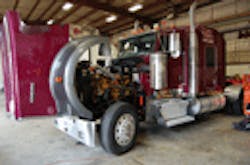EPA: Slow going for diesel retrofit funding
Despite being authorized by Congress to spend up to $200 million annually through 2011 to fund diesel engine retrofits, barely half that money is being used on a yearly basis at this point, according to new report issued by the Environmental Protection Agency (EPA).
According to the report, only $49.2 million out of the $200 million authorized by the Diesel Emissions Reduction Act (DERA) got spent during Fiscal Year (FY) 2008 for diesel vehicle retrofit projects across the country. Subsequent outlays for the next two years also remain relatively small – just $60 million in FY 2009, added to $20 million directly earmarked by Congress, with only $60 million projected to be spent in FY 2010.
Yet demand for diesel retrofit funds is high, said Allen Schaeffer, executive director of the Diesel Technology Forum. He pointed to more than 600 applications requesting $2 billion in grants submitted to the EPA earlier this year. These submissions seek to access $300 million worth of retrofit funding made available as part of the $787-billion American Recovery and Reinvestment Act, or “stimulus bill,” passed by Congress back in February..
“That $300 million is a separate pot of money from the DERA funds and has already been largely spent,” Schaeffer explained to FleetOwner. “But it’s a good measure of demand, as the $2 billion in retrofit funding requests put forth in such a short period of time for the ARRA funding shows how widespread the opportunities are for clean diesel retrofits.”
He noted that the DERA funds, incorporated within the Energy Policy Act of 2005, are designed to promote voluntary retrofit programs at both the national and state level. EPA distributes 70% of those funds through nationally competitive grant programs. The remaining 30% are dedicated for the states. Some of the monies are dedicated as matching funds, further leveraging the dollars Congress appropriates.
“While this report highlights many impressive accomplishments of the Diesel Emissions Reduction Funding Assistance program established by the EPA, imagine what further benefits could be achieved if the program was fully funded at its authorized $200 million level,” said Schaeffer. “We’re still spending less than half of what is authorized to help clean up diesel emissions.”
To date, EPA has only authorized 119 grant awards out of more than 230 applications from DERA funds. School bus and long-haul truck operations account for approximately 70% of those projects – though construction equipment, refuse hauling, delivery truck and transit bus retrofit projects received funding as well.
According to EPA’s data, those retrofit projects should reduce oxides of nitrogen (NOx) emission by more than 46,000 tons annually, alongside a 2,200 ton reduction in particulate matter and of 36,500 tons of carbon dioxide (CO2) – as well as produce fuel savings of 3.2 million gallons.
“This underscores why the clean diesel retrofit program is the nation’s best example of how public investment leveraged in a voluntary way can yield significant and proven cost-effective emissions benefits and real fuel savings,” said DTF’s Schaeffer.
Yet he noted that in the current federal budget climate, full DERA funding may not be practical. “A lot of political capital is invested in climate change legislation, energy policy, and other areas,” Schaeffer said. “My view is we should be thankful for what we’re getting to fund diesel engines retrofits – so we should go leverage the heck out of it.”
EPA’s full DERA report to Congress is available at www.epa.gov.
About the Author
Sean Kilcarr
Editor in Chief
Sean Kilcarr is a former longtime FleetOwner senior editor who wrote for the publication from 2000 to 2018. He served as editor-in-chief from 2017 to 2018.
